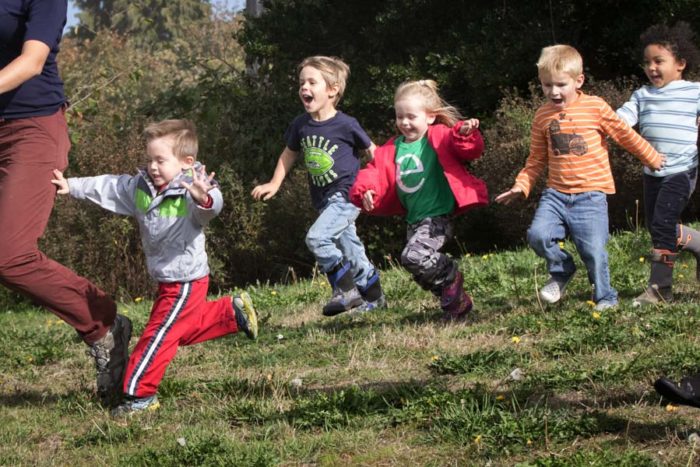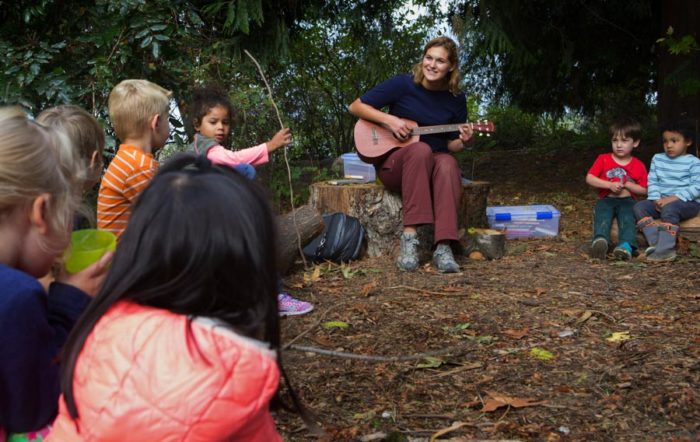
When I first heard about Tiny Trees Preschool, Seattle’s new outdoor-education offering, I thought it was bizarre. What about rain? What about stranger danger? What about the bathroom?
Then I heard it was almost half the price of other preschools, and I immediately signed my son up for the waitlist.
Because, in case you haven’t heard, childcare in this town is out-of-control-ruin-your-life expensive, as proven by a couple recently profiled in The Seattle Times who make almost $200,000 and struggle with childcare bills nonetheless.
I still had my doubts, though. Tiny Trees Preschool means an outdoor “classroom” in a public park — all day, year round, rain or shine.
“It’s a Scandinavian model, and it’s been around for 50 years,” says Tiny Trees CEO Andrew Jay. “We know that in much colder climates — Finland, Denmark, Norway — you go north of the Arctic Circle, you have outdoor preschools.”
Jay has spent almost two years working with a team of Tiny Trees evangelists, raising money (disclosure: I attended a Tiny Trees fundraiser last year) and building the program’s infrastructure. This month, they launched six outdoor classrooms serving 160 children in parks around Seattle.
Jay says parents share my worries about weather, safety and bathroom facilities. Those concerns are addressed — respectively — with Tiny Trees-issued rain gear, teachers trained to interact with curious members of the public, and a kid-friendly, portable toilet exclusive to preschool use.
But parents have other questions, too.
“I get the academics question a lot,” said Jay, who explains that Tiny Trees believes in building a “sensory vocabulary” and emphasizing speaking, listening and communication skills, all lessons he believes are well-served by the outdoor environment.

“We can read a book about nature and the out-of-doors, and a lot of the things in that book are in this park,” says Jay, gesturing across the Jefferson Park classroom. “Whereas when you’re in an indoor space, sometimes that book can feel a little more abstract.”
When I visited, 12 children had just dispersed from snack time on a big, green tarp and were playing in small groups, or on their own. Some engaged in make-believe beneath the boughs of a giant cedar, some smashed playdough on a giant, wood stump and others explored spider webs in the crevices of a mulch pit.
All did so under the watchful guidance of two teachers and a classroom volunteer.
Tiny Trees isn’t the only organization doing outdoor schooling in our region. There’s also one at the Arboretum and on Vashon Island, but Tiny Trees is hoping to popularize the model for a city in child-care crisis.
“It’s hard for preschools, because it’s not very profitable to compete with doggy day care and restaurants and bars in a really hot real-estate market,” says Jay, who estimates full-time day care in Seattle costs around $1,600 a month.
“So our solution is we go outside,” he says.
“When little kids get that exposure, they know they belong to nature, and nature belongs to them.”
Over half of enrolled families qualify for assistance, which cuts those costs by 40 percent. But it’s not just economic equity that appeals to Tiny Trees parents.
“As a young woman of color, it’s important for my daughter,” parent Teddy McGlynn-Wright says of his daughter, citing the statistic that only 22 percent of visitors to national parks are racial and ethnic minorities. “When little kids get that exposure, they know they belong to nature, and nature belongs to them.”
And McGlynn-Wright says he wants his daughter to gain the confidence that comes with time spent outdoors.
“I’m the kind of parent who wants his kid to get some bumps and bruises and scratches,” he says. “If she’s coming home and her clothes are all clean, she hasn’t been playing hard enough.”
As I left Jefferson Park I got a sense of that type of play. I was rounding the corner to my car when I heard the sound of children screaming with glee. I turned to see the Tiny Trees students tumbling akimbo down a sunny green slope behind me.
The scene echoed the words of lead teacher Rachel Franz.
“All early educators know that play is learning, and that’s what we’re doing here,” says Franz. “We’re celebrating childhood as it is and as it should be.”
And who wouldn’t want that for their kid, regardless of cost.

